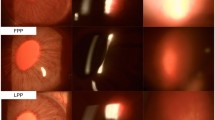Abstract
The retinal toxicity of intraocular liposome-bound cyclosporine was studied in albino rabbits by means of electrophysiology and histopathology. During a followup period of one month, no histopathological or electroretinographic changes were noted using concentrations of 100, 200 and 500 micrograms injected intravitreally.
Similar content being viewed by others
References
Alghadyan AA, Peyman GA et al. Liposome-bound cyclosporine. Part 1. Aqueous and vitreous level after subconjunctival injection, this issue; 95–98.
Bell TAG, Easty DL, McCullagh KG. A placebo controlled blind trial of cyclosporin A in prevention of corneal graft rejection in rabbits. Br J Ophthalmol 1982; 66: 303–08.
Coster DJ, Shepard WFI, Chin Fook T et al. Prolonged survival of a corneal allograft in rabbits treated with cyclosporin A. Lancet 1979; ii: 688–89.
Grisolano J, Peyman GA. Retinal toxicity study of intravitreal injection of cyclosporin. Ophthalmic Surg 1986; 17: 155–6.
Hunter PA, Wilhelmus KR, Rice NSC et al. Cyclosporin A applied topically to the recipient eye inhibits corneal graft rejection. Clin Exp Immunol 1981; 45: 173–77.
Kana JS, Hoffman F, Buchen R et al. Rabbit corneal allograft survival following topical administration of cyclosporin A. Invest Ophthalmol Vis Sci 1982; 22: 686–90.
Magin RL, Niesman M. Temperature-dependent permeability of large unilamellar liposomes. Chem Phys Lipids 1984; 34: 245–56.
Magin RL, Weinstein JN. Design and characterization of temperature sensitive liposomes. In: Gregoriadis G, ed. Liposomes technology III. Boca Raton, Florida; CRC Press, 1983:137–55.
Nussenblatt RB, Palestine AG. Cyclosporin: immunology, pharmacology, and therapeutic uses. Surv Ophthalmol 1986; 31: 159–69.
Oh JO, Minasi P, Grabrer G et al. Suppression of secondary herpes simplex uveitis by cyclosporin. Invest Ophthalmol Vis Sci 1985; 26: 494–599.
Rousell TJ, Osato MS, Wilhelmus KR. Cyclosporine and experimental corneal transplantation. Transplant Proc (Suppl) 1983; 15: 3081–83.
Salisbury JD, Gebhardt BM. Suppression of corneal allograft rejection by cyclosporin A. Arch Ophthalmol 1981; 99: 1640–43.
Shepard WFI, Coster DJ, Chin Fook T et al. Effect of cyclosporin A on survival of corneal grafts in rabbits. Br J Ophthalmol 1980; 64: 148–53.
Szoka F, Papahadjopoulos D. Procedure for preparation of liposomes with large internal aqueous space and high capture by reverse-phase evaporation. D Proc Natl Acad Sci USA 1978; 75: 4194–98.
Tremblay C, Barza M, Fiore C. et al. Reduced toxicity of liposomes associated amphotericin B injected intravitreally. Invest Ophthalmol Vis Sci 1985; 26: 711–18.
Author information
Authors and Affiliations
Rights and permissions
About this article
Cite this article
Alghadyan, A.A., Peyman, G.A., Khoobehi, B. et al. Liposome-bound cyclosporine: Retinal toxicity after intravitreal injection. Int Ophthalmol 12, 105–107 (1988). https://doi.org/10.1007/BF00137134
Accepted:
Issue Date:
DOI: https://doi.org/10.1007/BF00137134




